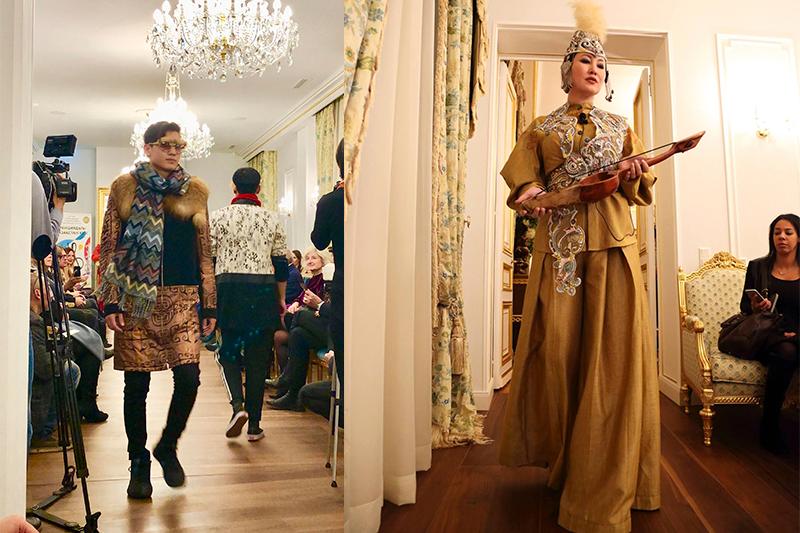Kazakhstani traditional clothing and jewelry went on display in Paris, showcasing the versatility and distinctiveness of the cultures found within one of the Caspian region’s largest and most rapidly developing countries.
A one-day cultural extravaganza on November 29 featured fashion collections designed by Kairolla Abishev, a founder of Zeken Moda; and Aidarkhan Kaliev, a founder of Aspara Fashion Week. Nurdos Aliaskarov, a bench jeweler, presented handcrafted jewelry designed in traditional Kazakhstani styles.
“Designers have a very peculiar taste, and this is what I value. I’m attracted to original ideas, an extraordinary approach to work. I’m always interested to see what is different from others,” said Hind Joudar, the founder and president of the Oriental Fashion Week show, who was among the visitors at the event.
Attendees included French Senator Natalie Goulet; Dusen Kasseinov, the head of the Turkic international cultural organization called TURKSOY; and representatives from companies including Pierre Cardin from France and Bulgari from Italy.
Musical accompaniment at the event was provided by the Bastau – a duo playing the dombra, the Kazakhstani national musical instrument – and Gulnur Orazymbetova who sang Kazakhstani folk songs. Attendees had an opportunity to taste some national cuisine as well. The event was the last in a program series called “Kazakhstan’s autumn in France” and initiated by the country’s embassy.
But it is President Nursultan Nazarbayev’s “Ruhani Zhanyru” project that is ultimately responsible for the cultural push. Ruhani Zhanyru is meant to revitalize the “spiritual values of Kazakhstan citizens, taking into account all the modern risks and challenges of globalization,” according to a government website.
“President Nazarbayev’s initiatives to revive the culture and strengthen the unity of the multi-ethnic people are the cement of the nation,” said Didier Vidal, the Editor In Chief of La Lettre Diplomatique, according to reports by Atameken.
The idea behind the concept of using traditional clothing to promote Kazakhstan was to integrate elements of folk art into modern European looks. Throughout the centuries, clothes of ethnic Kazakhs were distinguished by simplicity, and leather, fur and thin felt were used as the main materials to manufacture traditional attire for Kazakhstanis. Ornaments, including jewelry, were the main decorations on attire because art, painting, drawing and sculpture were not as developed in the territories until the mid-20th century.
The most popular ornaments displayed various bird beaks and different animal horns, hooves and feet, and would indicate a wearer’s social status, age, and tribal affiliation. For example, materials such as silk, brocade and velvet indicated wealth and well-being.







 President Ilham Aliyev shed light on the evolving contours of the peace process with Armenia during an international conference in Baku this week. ...
President Ilham Aliyev shed light on the evolving contours of the peace process with Armenia during an international conference in Baku this week. ...
 Azerbaijan and Armenia started the process of demarcation of their border on Tuesday, with the installation of the first border markers based on ge...
Azerbaijan and Armenia started the process of demarcation of their border on Tuesday, with the installation of the first border markers based on ge...
 President Aliyev emphasized the critical role of the North-South Transport Corridor in fostering transport cooperation between Azerbaijan and Russi...
President Aliyev emphasized the critical role of the North-South Transport Corridor in fostering transport cooperation between Azerbaijan and Russi...
 Russian Foreign Minister Sergei Lavrov has reasserted that Moscow has no intentions to stop the fighting in Ukraine, even if peace talks commence.
Russian Foreign Minister Sergei Lavrov has reasserted that Moscow has no intentions to stop the fighting in Ukraine, even if peace talks commence.
 Iran has refuted reports of alleged damage to Shimon Peres Negev Nuclear Research Centre located southeast of Dimona, Israel, during the recent air...
Iran has refuted reports of alleged damage to Shimon Peres Negev Nuclear Research Centre located southeast of Dimona, Israel, during the recent air...
 Iran and Pakistan have signed eight cooperation documents in various fields, and agreed to strengthen ties to fight terrorism in the region.
Iran and Pakistan have signed eight cooperation documents in various fields, and agreed to strengthen ties to fight terrorism in the region.



